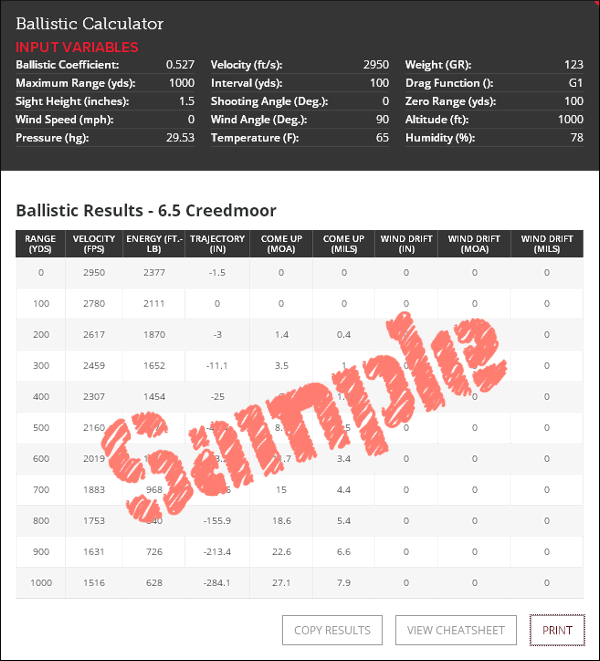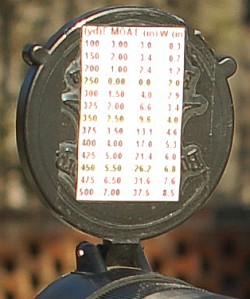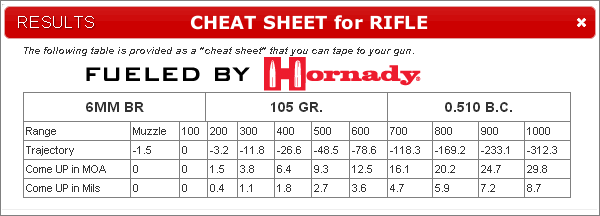|
|
February 20th, 2018

 Need a simple, easy-to-use drop chart for your rifle? Something you can tape right to the buttstock? Then check out Hornady’s handy Online Ballistics Calculator. This user-friendly calculator will compute your drops accurately, and output a handy “Cheat Sheet” you can print and attach to your rifle. Simply input G1 or G7 BC values, muzzle velocity, bullet weight, zero range, and a few other variables. Click “Calculate” and you’ll see the full chart (shown below). Then if you click “View Cheatsheet”, you can generate the simpler, 4-line Drop Chart (shown above). Need a simple, easy-to-use drop chart for your rifle? Something you can tape right to the buttstock? Then check out Hornady’s handy Online Ballistics Calculator. This user-friendly calculator will compute your drops accurately, and output a handy “Cheat Sheet” you can print and attach to your rifle. Simply input G1 or G7 BC values, muzzle velocity, bullet weight, zero range, and a few other variables. Click “Calculate” and you’ll see the full chart (shown below). Then if you click “View Cheatsheet”, you can generate the simpler, 4-line Drop Chart (shown above).
The online ballistics caculator is easy to use. You can select the basic version, or an advanced version with more data fields for environmental variables (altitude, temperature, air pressure, and humidity). You can also get wind drift numbers by inputing wind speed and wind angle.
Conveniently, on the trajectory output, come-ups are listed in both MOA and Mils — so this will work with either MOA clicks or Mil-based clicks. There are more sophisticated ballistics solvers available on the web (such as the outstanding Applied Ballistics Online Calculator), but the Hornady Calculator is very simple and easy to use. If you just want a basic drop chart, you may want to check this out.

Share the post "Generate “Cheat Sheet” — Printable Drop Chart for Your Rifle"
July 14th, 2016

Tactical ace Zak Smith of Thunder Beast Arms employs a simple, handy means to store his elevation and wind dift data — a laminated data card. To make one, first generate a come-up table, using one of the free online ballistics programs such as JBM Ballistics. You can also put the information in an Excel spreadsheet or MS Word table and print it out. You want to keep it pretty small.
Above is a sample of a data card. For each distance, the card includes drop in inches, drop in MOA, drop in mils. It also shows drift for a 10-mph cross wind, expressed three ways–inches, MOA, and mils. Zak explained that “to save space… I printed data every 50 yards. For an actual data-card, I recommend printing data every 20 or 25 yards.” But Zak also advised that you’ll want to customize the card format to keep things simple: “The sample card has multiple sets of data to be more universal. But if you make your own data card, you can reduce the chance of a mistake by keeping it simple. Because I use scopes with MILS, my own card (photo below left) just has three items: range, wind, drop in MILS only.”
Once you have the card you can fold it in half and then have it laminated at a local office store or Kinko’s. You can keep this in your pocket, tape it to your stock, or tie the laminated card to your rifle. If you regularly shoot at both low and high elevations, you may want to create multiple cards (since your ballistics change with altitude). To learn more about ballistic tables and data cards, check out the excellent Practical Long-Range Rifle Shooting–Part 1 article on Zak’s website. This article offers many other insights as well–including valuable tips on caliber and rifle selection.
 Scope-Cover Mounted Ballistics Table Scope-Cover Mounted Ballistics Table
Another option is to place your ballistics card on the back of the front flip-up scope cover. This set-up is used by Forum member Greg C. (aka “Rem40X”). With your ‘come-up’ table on the flip-up cover you can check your windage and elevation drops easily without having to move out of shooting position.
Greg tells us: “Placing my trajectory table on the front scope cover has worked well for me for a couple of years and thought I’d share. It’s in plain view and not under my armpit. And the table is far enough away that my aging eyes can read it easily. To apply, just use clear tape on the front objective cover.”
Share the post "Dope for Your Scope — Handy Laminated Ballistics Card"
October 12th, 2015

 Need a simple, easy-to-use drop chart for your rifle? Something you can tape right to the buttstock? Then check out Hornady’s handy Online Ballistics Calculator. This user-friendly calculator will compute your drops accurately, and output a handy “Cheat Sheet” you can print and attach to your rifle. Simply input G1 or G7 BC values, muzzle velocity, bullet weight, zero range and a few other variables. Click “Calculate” and you’re good to go. You can select the basic version, or an advanced version with more data fields for environmental variables (altitude, temperature, air pressure, and humidity). You can also get wind drift numbers by inputing wind speed and angle. Need a simple, easy-to-use drop chart for your rifle? Something you can tape right to the buttstock? Then check out Hornady’s handy Online Ballistics Calculator. This user-friendly calculator will compute your drops accurately, and output a handy “Cheat Sheet” you can print and attach to your rifle. Simply input G1 or G7 BC values, muzzle velocity, bullet weight, zero range and a few other variables. Click “Calculate” and you’re good to go. You can select the basic version, or an advanced version with more data fields for environmental variables (altitude, temperature, air pressure, and humidity). You can also get wind drift numbers by inputing wind speed and angle.
Conveniently, on the trajectory output, come-ups are listed in both MOA and Mils — so this will work with either MOA clicks or Mil-based clicks. There are more sophisticated ballistics solvers available on the web (such as the outstanding Applied Ballistics Online Calculator), but the Hornady Calculator is very simple and easy to use. If you just want a basic drop chart, you may want to check this out.

Share the post "Print Handy Drop-Chart with FREE Hornady Ballistics Calculator"
September 23rd, 2012
 Hornady just unveiled its “new and improved” online Ballistics Calculator. It’s free, fast, and easy to use. New enhancements include selectable G1 or G7 BCs, drop and windage in MOA and MILS, metric value option, and the ability to enter shooting angle, wind angle, and more. To access all these features (such as G7 BCs), you’ll need to select the “advanced” display from Hornady’s Ballistic Calculator Entry Page. That will open up more entry fields. Default values are entered in the temperature and pressure fields, but you can override these with your actual field data. You can select a zero range from 0 to 2000 yards, with intervals from 25 to 400 yards. Once you’ve entered all the values, simply click “Calculate” and the program provides your drop numbers in a handy chart. Hornady just unveiled its “new and improved” online Ballistics Calculator. It’s free, fast, and easy to use. New enhancements include selectable G1 or G7 BCs, drop and windage in MOA and MILS, metric value option, and the ability to enter shooting angle, wind angle, and more. To access all these features (such as G7 BCs), you’ll need to select the “advanced” display from Hornady’s Ballistic Calculator Entry Page. That will open up more entry fields. Default values are entered in the temperature and pressure fields, but you can override these with your actual field data. You can select a zero range from 0 to 2000 yards, with intervals from 25 to 400 yards. Once you’ve entered all the values, simply click “Calculate” and the program provides your drop numbers in a handy chart.
Printable ‘Cheat Sheet’ for your Rifle
One very cool feature of Hornady’s online calculator is the “Cheat Sheet” — a handy, printable come-up table. Once you’ve entered your variables and run the calculator, the results appear in a handy table that you can print-out and affix to your rifle stock. Here’s a sample Cheat Sheet prepared for Berger’s 105gr VLD and a 6mm Dasher*.

Although it can employ G7 BCs now, the Hornady Ballistic Calculator, unlike the JBM online solver, does NOT include a built-in database of G7 values, based on field-testing by Bryan Litz. For that reason, the JBM Ballistics Calculator is still our first choice for an online ballistics solver. We really do like Hornady’s handy “Cheat Sheet” option though. You can, of course, get a Litz-derived G7 value from JBM and then plug that number into the Hornady Calculator to produce a printable drop table.
*NOTE: Note: Even if you have a Dasher and use the Berger 105gr VLDs, you should run your own solution with your specific sight height, elevation, temp, pressure, humidity, and zero distance.
Share the post "New Hornady Ballistic Calculator Generates Printable Drop Chart"
|
 Need a simple, easy-to-use drop chart for your rifle? Something you can tape right to the buttstock? Then check out Hornady’s handy Online Ballistics Calculator. This user-friendly calculator will compute your drops accurately, and output a handy “Cheat Sheet” you can print and attach to your rifle. Simply input G1 or G7 BC values, muzzle velocity, bullet weight, zero range, and a few other variables. Click “Calculate” and you’ll see the full chart (shown below). Then if you click “View Cheatsheet”, you can generate the simpler, 4-line Drop Chart (shown above).
Need a simple, easy-to-use drop chart for your rifle? Something you can tape right to the buttstock? Then check out Hornady’s handy Online Ballistics Calculator. This user-friendly calculator will compute your drops accurately, and output a handy “Cheat Sheet” you can print and attach to your rifle. Simply input G1 or G7 BC values, muzzle velocity, bullet weight, zero range, and a few other variables. Click “Calculate” and you’ll see the full chart (shown below). Then if you click “View Cheatsheet”, you can generate the simpler, 4-line Drop Chart (shown above).














 Scope-Cover Mounted Ballistics Table
Scope-Cover Mounted Ballistics Table








